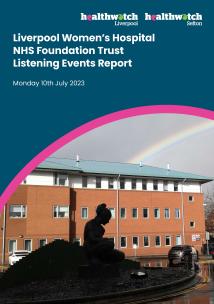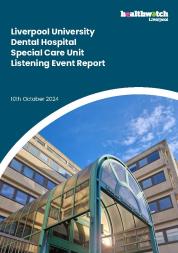Liverpool Women's Hospital Listening Event Report - July 2023

This report was produced jointly by Healthwatch Liverpool and Healthwatch Sefton. On Monday 10th July 2023 we held a Listening Event at Liverpool Women’s NHS Foundation Trust. We spoke with patients, family members and staff at the Women’s Hospital and listened to what they had to say about their experiences. 20 surveys were completed with patients and family members while several staff members also gave us feedback.
We visited on a Monday as we were particularly interested to find out more about the work of the Non-English Speaking Team (NEST) who provide support to patients who do not have English as a first language. The Team provides a drop-in service for non-English speaking patients on Mondays. We also spoke with people in the Antenatal Clinic waiting area, Outpatient departments as well as those on Maternity, Gynaecology and Neonatal wards.
‘15 Steps Challenge’: Antenatal Clinic Waiting Area
The NHS ’15 Steps Challenge’ includes a range of toolkits which explore different healthcare settings through the eyes of patients and relatives. The toolkits help to explore patient experience by involving patients, carers and families in quality assurance processes. In this case, the Trust invited Healthwatch Liverpool, Healthwatch Sefton and a representative from Liverpool Maternity Voices Partnership (MVP) to assess the Antenatal Clinic waiting area within 15 steps of entering it .
The Healthwatch observations were:
- The clinic waiting rooms were mostly clean, calm and organised. There were no strong odours but there were some small stains on the floor and ceiling tiles. Bins were available and chairs and floors were visibly clean. The temperature was comfortable and a water cooler was available
- The area was bright/well-lit, and the walls were white which gave quite a clinical feel. Perhaps other colours may have felt more welcoming. Room 9 looked less clinical and had art/murals on the wall and a sofa. We didn’t notice any facilities for young children.
- The overall feel was welcoming but there was no reception area where patients could check they were in the correct place. However, staff were visible and we saw them interacting with patients and answering questions.
- Staffing information was not completed on the information boards used to indicate who was on duty in the clinic that morning.
- There didn’t appear to be any long waits at the time we visited (approximately 10:15 – 10:55am) and appointments were flagged up by sound and text alerts.
- We didn’t see any translated information available on notice boards (except in information produced by the Care Quality Commission (CQC)), or information about how to access translated information if required. Notice boards were tidy and up-to-date, although there were a lot of requests for research participants and some of this included jargon and terminology which may not be immediately accessible to all. Posters often had quite small text and could be hard to read unless standing very close which wasn’t always possible.
- We felt that there could have been more hand gel dispensers on the walls.
- Signage for the toilets was not clear from all directions and there was no male toilet in the area for use by male partners, only female or Accessible toilets, although we saw several male partners in the area.
- We observed wheelchairs being stored along a corridor which may have impacted on access for some patients/families.
- A sign for ‘Waiting Area C’ by Rooms 10-12 was confusing. It pointed left but there was just a corridor in that direction and no chairs. However, other signage seemed clear.
Comments, Questions and Recommendations
- On the day of the visit we had a discussion with staff about the re-introduction of overnight stays for partners following childbirth. Several issues were raised including:
- The Trust’s duties to mothers and babies being the prime consideration of the hospital and its staff
- Contracts that partners must agree to abide by in relation to their behaviour on hospital premises, including appropriate clothing and not sleeping in vacant hospital beds
- The lack of comfortable space for partners at present.
We understand all these points and support the Trust’s position on them but we recommend ongoing dialogue with patients and partners about how best to balance their comfort and wellbeing with the Trust’s duty of care.
-
We also had some questions about safeguarding when partners stay with birth parents at all times, particularly as this relates to people in coercive/abusive relationships. Our concern was that opportunities to speak up when alone could now have been removed. Closed curtains around bays may also provide opportunities for coercive/abuse behaviour to go unnoticed.
Has the Trust put any actions in place to address these potential problems? For example, through providing information about how to speak up (e.g. posters in toilets) or staff requesting opportunities to speak to the birth parent alone?
- We would like to see more diverse patients and families represented throughout the Trust’s communications materials and would support any initiatives to promote further diversity, visibility and inclusion in publicity, posters and information leaflets. This should include not just cultural diversity but also different types of families (e.g. same-sex parents, lone parents, parents with disabilities, trans parents).
-
Although the feedback we received was very positive overall, one patient’s account of a previous experience at the hospital did cause us some concern. This patient told us that she’d felt violated by a previous procedure at the hospital and had not received an apology after she’d raised the issue, although the patient had been assured that they would not be treated again by the staff member involved in the incident. We raised this case in more detail with the Trust on the day of our visit.
We would be interested to know how the Trust addresses complaints against staff where patients feel a staff member, or members, have acted inappropriately (whether deliberately or not); and whether patients are clearly reminded that they have a right to a chaperone during examinations, procedures, treatments or care.
- We were impressed by the work of the NEST staff and recommend additional resources for this team where possible.
- Improved internet connectivity for the Interpreter on Wheels service, and more generally across the hospital site would be welcomed.
- More allergy information on patient menus, or information on who to ask/where to find this would be helpful.
- Are menus available in Easy Read or alternative formats (e.g. with reduced design features, with large font, on different coloured backgrounds or in other languages) for patients who may find this helpful?
- It is important that all corridors are well lit, for health and safety reasons and to limit any negative impact on people with visual or mobility impairments.
- We didn’t notice any information about Healthwatch displayed in any of the areas we visited and would welcome an opportunity to discuss displaying Healthwatch posters on site with contact details including QR codes to enable patients or family members to provide feedback to us as an independent organisation, which we would then be able to share with the Trust. Similar posters have been very successful at Liverpool University Hospitals NHS Foundation Trust (LUHFT).
- We would be interested to know about any plans that the Trust has regarding future equality of access to Breast Start support for patients across Liverpool, Sefton, Knowsley and beyond.
- Although 60% of the people we spoke to felt that the Trust had provided them with enough information about their appointment/treatment it would be useful to explore with patients what kind of information they would expect to receive or like to see from the hospital – to ensure that the needs of different patient cohorts are met.
- It was good to learn that Liverpool Women’s Hospital is working closely with Merseyside Society for Deaf People (MSDP) to make services more accessible to deaf and hard-of hearing patients and we are interested to know more about this. We would also welcome the introduction of e.g. Frequently Asked Questions (FAQ) leaflets and/or videos in commonly requested community languages and in Easy Read versions.#
- We support the Trust’s increasing development of links with community organisations e.g. The Whitechapel Centre, the Rotunda, Irish Community Care Merseyside (ICCM) and other organisations supporting homeless people, sex workers, Travellers, people seeking asylum and refugees. This is important work in terms of inclusion, reducing health inequalities and improving public health. We also welcome the Trust’s recognition of ‘poverty’ as an additional protected characteristic.
- We recognise that the Trust works hard to balance an emphasis on the positive aspects of birth and parenthood with a sensitivity to the needs of parents and families experiencing bereavement and grief. Nonetheless, it must be difficult for bereaved parents to see pictures of babies and happy families around them, although we realise that this may be hard to address.
- We liked the informal touch of seeing clinics called e.g. ‘Dr Kiran’s Clinic’ or ‘Dr Kate’s Clinic’.
- The Outpatient’s area was not very busy when we visited and we’d therefore like to come back again soon to gather feedback from more people using Outpatients clinics.
Thanks again to all staff, patients and family members who made us so welcome and helped to make our visit so informative and constructive.
Liverpool Women's Hospital Foundation Trust have provided a comprehensive response to the comments and questions raised in this report which are included in full in the report document.
Downloads
If you need this report in a different format, please email enquiries@healthwatchliverpool.co.uk or call 0300 77 77 007.

